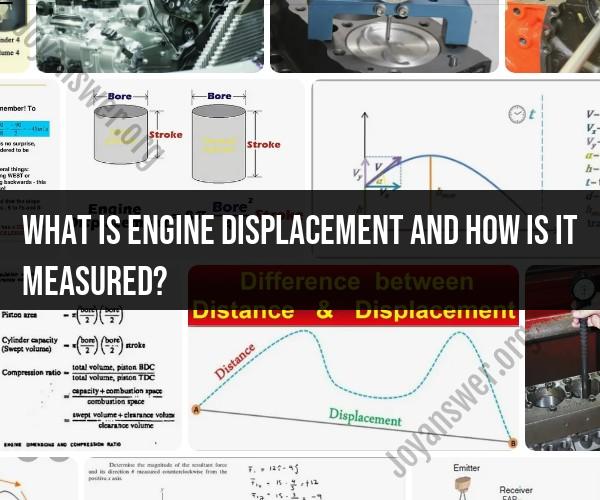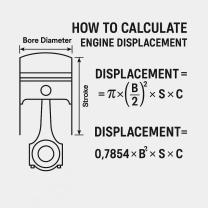What is engine displacement and how is It measured?
Engine Displacement:
Definition:Engine displacement, also known as engine capacity or cylinder volume, refers to the total volume of all the cylinders in an internal combustion engine. It is a fundamental specification that reflects the size of an engine and is often expressed in cubic centimeters (cc) or liters (L). Engine displacement is a crucial factor in determining an engine's power and performance characteristics.
Measurement Techniques:
Bore and Stroke Measurements:
Bore (B): This is the diameter of one of the engine cylinders. It is the distance from one side of the cylinder wall to the other, passing through the center of the cylinder.
Stroke (S): This is the distance the piston travels up and down within the cylinder. It is the distance from the top (TDC - Top Dead Center) to the bottom (BDC - Bottom Dead Center) of the cylinder.
Formula:
Manufacturer Specifications:
- Check the vehicle's documentation, including manuals or online resources, for information on engine displacement. Manufacturer specifications often provide this information directly.
Engine Codes:
- Engine codes, usually found on the engine itself or in the vehicle's documentation, can be used to identify and cross-reference the engine displacement.
VIN (Vehicle Identification Number):
- The VIN may contain information about the vehicle, including the engine size. The eighth digit in the VIN is often used to identify the engine.
Measuring Cylinder Volume:
Measure the bore (diameter) and stroke (height) of one cylinder.
Calculate the volume of one cylinder using the formula for the volume of a cylinder: , where is the radius (half of the bore diameter) and is the stroke.
Multiply the volume of one cylinder by the number of cylinders in the engine.
Formula:
The most common units for engine displacement are cubic centimeters (cc) and liters (L). Larger engine displacement values often indicate more powerful engines, but other factors such as efficiency, turbocharging, and other technologies also play a role in overall engine performance.
Explaining engine displacement and its measurement techniques
Sure, here is an explanation of engine displacement and its measurement techniques:
What is Engine Displacement?
Engine displacement is a measure of the volume swept by the pistons in an internal combustion engine. It is typically measured in cubic centimeters (cc) or liters (L), and it is a key factor in determining the power and torque of an engine.
The larger the engine displacement, the more air and fuel the engine can intake and compress, which can potentially produce more power. However, larger engines also tend to be heavier and less fuel-efficient than smaller engines.
How is Engine Displacement Measured?
There are two main methods for measuring engine displacement:
Method 1: Using the Cylinder Bore and Stroke
Measure the cylinder bore: The cylinder bore is the diameter of the cylinder. You can use a caliper to measure the bore diameter across the piston ring grooves.
Measure the stroke: The stroke is the distance the piston travels from top dead center (TDC) to bottom dead center (BDC). You can measure the stroke using a dial gauge or by removing the cylinder head and measuring the distance between the piston top and the crankshaft.
Calculate the displacement: Once you have the bore and stroke, you can calculate the displacement using the following formula:
Displacement = (Bore/2)² * π * Stroke * Number of Cylinders
Method 2: Using the Engine Displacement Formula
You can also use the engine displacement formula to calculate the displacement without measuring the bore and stroke. This formula is typically used for engines with a known bore and stroke or for engines where the bore and stroke are difficult to measure.
The engine displacement formula is:
Displacement = (π/4) * Bore² * Stroke * Number of Cylinders
Where:
- Bore is the cylinder bore in inches
- Stroke is the stroke in inches
- Number of Cylinders is the number of cylinders in the engine
Once you have calculated the displacement, you can convert it to cubic centimeters (cc) or liters (L) using the following conversion factors:
- 1 cubic inch (CID) = 16.3871 cubic centimeters (cc)
- 1 liter (L) = 1000 cubic centimeters (cc) = 61.0237 cubic inches (CID)
Factors Affecting Engine Displacement
The engine displacement of a particular engine is determined by several factors, including:
The number of cylinders: The more cylinders an engine has, the larger the displacement will be.
The bore: The larger the bore of the cylinders, the larger the displacement will be.
The stroke: The longer the stroke of the pistons, the larger the displacement will be.
Applications of Engine Displacement
Engine displacement is used in a variety of applications, including:
Automotive: Engine displacement is a key factor in determining the power and torque of an engine, which are important for performance and fuel efficiency.
Aviation: Engine displacement is used to determine the power of aircraft engines.
Marine: Engine displacement is used to determine the power of marine engines.
Industrial: Engine displacement is used to determine the power of industrial engines.
Conclusion
Engine displacement is an important factor to consider when choosing an engine for a particular application. Larger engines tend to be more powerful, but they also tend to be heavier and less fuel-efficient. Smaller engines tend to be less powerful, but they are also lighter and more fuel-efficient. The best engine displacement for a particular application will depend on the specific needs of the application.













